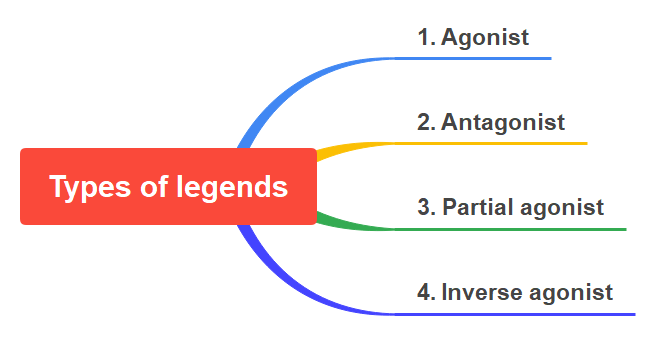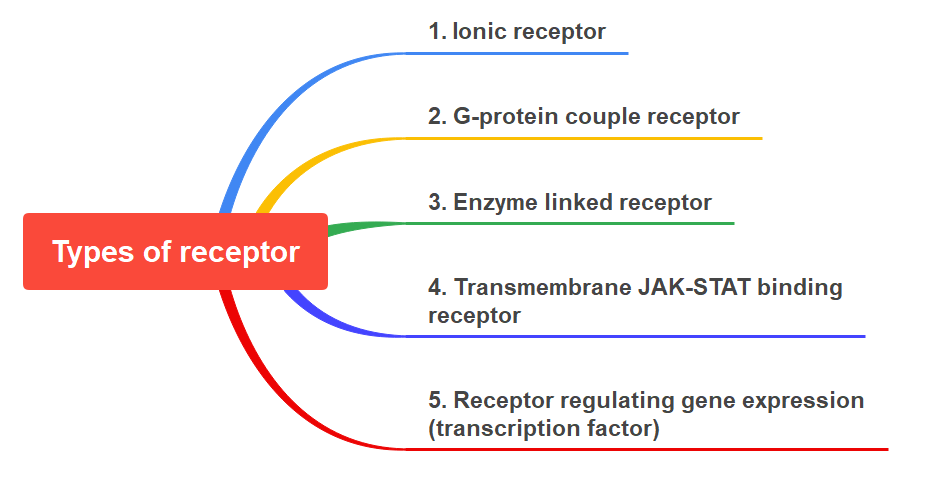Table of Contents
Receptor and it’s types
Receptor is a special structure which is made up of protein and its present on surface of organ. Receptor and drug structure is like lock and key mechanism and when drug is bind with receptor then it produce response. Any molecule which bind with receptor and give certain response is called a legend molecule. When drug bind with receptor than it form drug receptor complex and after formation of complex, response is produced.
Types of legends
1. Agonist
Agonist are those legend molecule which have similar structure and action to the natural drug, their affinity 100% and efficiency is also 100%.
2. Antagonist
Those legend molecule which affinity is 100% but efficiency 0%, so they bind with receptor completely but produce no response.
3. Partial agonist
Those legend molecule which is not completely bind with the receptor and produce less response is called a partial agonist, there affinity and efficiency is less than 100%.
4. Inverse agonist
Those legend molecule which completely bind with the receptor and produce opposite response, so there affinity is 100% and efficiency is also 100% but response is opposite.
Types of receptor
On the basis of structure and function a structure of types:-
1. Ionic receptor
2. G-protein couple receptor
3. Enzyme linked receptor
4. Transmembrane JAK-STAT binding receptor
5. Receptor regulating gene expression (transcription factor)
1. Ionic receptor
Ionic receptor is present on the structure of cell membrane. This receptor produce the action due to movement of respective ions like- Na ion, K ion, Cl ion and Ca ion etc so, it is called ionic receptor. Ionic receptor is present around the ionic channel and when drug bind with the receptor then ionic channels are open and the moment are ion takes place from ECF to ICF and action is generated. Ex- adrenergic and dopaminergic receptor are the ionic receptor.
2. G-protein couple receptor
GPCR receptor is a family of cell membrane. Receptor which is activated by G-protein this receptor is made up by seven Hepta helical membrane which are connected each other. G-protein-coupled receptors (GPCRs) are a class of integral membrane proteins that serve as transducers, receiving signals from the extracellular environment and converting them into intracellular biological responses.
GPCRs bind to extracellular ligands and activate an intracellular signaling cascade through the interaction with their own G-proteins. This mechanism is known as the G-protein coupled receptor mechanism and is crucial for the transmission of signals from outside to inside the cells.
They are found in all kingdoms of biology, including mammals, plants, fungi, and bacteria. GPCRs act as gatekeepers for chemical signals in the body; they receive signals from hormones or other molecules and transmit them to downstream signaling pathways inside the cell.
The GPCR receptor produce action by following three pathway-
1. Adenyl cyclase pathway CAMP systems
Activation of AC result in intracellular accumulation of second messenger CAMP, which function through after’s the function of many enzymes, ion channels trans-proteins and structural proteins.
2. Phospholipase DAG pathway
Activation of phospholipase, hydrolysis the membrane PIP to generate IP and DAG. IP mobilizes cat and DAG enhances protein kinase activation by cat.
3. Ion channel regulation
The activated G-protein can also open or close ionic channels specific for Ca++, K or Na without the intervention of drug second messenger like cAMP or IP and bring about depolarization hyperpolarization changes in intracellular cat.
3. Enzyme linked receptor
This type of receptor is activated by the enzyme tyrosine, kinase and produce action. When drug agonist is bind with the binding site an alpha-helix than it and form dimer. Some inactive protein are present in ICF but when drug bind with the receptor it becomes active. Now protein by bind with the tyrosine receptor and produce different response by phosphorylation.
An enzyme-linked receptor is a type of protein found in the cell membrane of many types of cells that binds to a specific ligand, such as a hormone or neurotransmitter. The binding stimulates the enzyme activity inside the cell, which can lead to various physiological changes.
4. Transmembrane JAK-STAT binding receptor
It is similar as RTK’s receptor but they do not having any catalyst domain. Many cytokines, growth hormone, prolactin, interferons etc act through this type of receptor. The transmembrane JAK-STAT binding receptor is an important component of the immune system, particularly in eukaryotic cells. It plays a vital role in the regulation of cellular responses to external stimuli and in the maintenance of homeostasis.
Mechanism
1. Agonist binds and induced dimerization, which after the intracellular domain confirmation to increase its affinity for a cytosolic tyrosine protein kinase JAK(Janus kinase).
2. On binding, JAK gets activated and phosphorylated tyrosine residues of the receptor.
3. Which now bind another free moving protein STAT(signal transducer and activator of transcription), which is also phosphorylated by JAK.
4. Pair of phosphorylated STAT dimerize.
5. Translocate to the nucleus to regulate gene transcription. Then it is produce biological response.
5. Receptor regulating gene expression (transcription factor)
These are intracellular receptor which are present inside the cell. They contain soluble protein which responds to lipid soluble chemical messenger that penetrate the cell. Receptor regulating gene expression, or transcription factor, plays a critical role in the regulation of gene expression. It is a protein that binds to DNA and initiates the process of transcription. The receptor regulates gene expression by controlling which genes are expressed and in what amount.
Transcription factors are essential for proper functioning of cells and organisms as they control the production of proteins from genetic information contained in DNA. In addition, they can regulate the timing, rate and level of gene expression, thus allowing for adaptability to changing environmental conditions.
In order to understand how receptor regulating gene expression works, it is important to understand how its components interact with each other at different levels such as DNA binding, mRNA production, splicing and translation into proteins. Through this understanding we can gain insight into how these receptors act as regulators in gene networks and further our understanding of cellular function.




To the mimprovement.com owner, Your posts are always a great read.